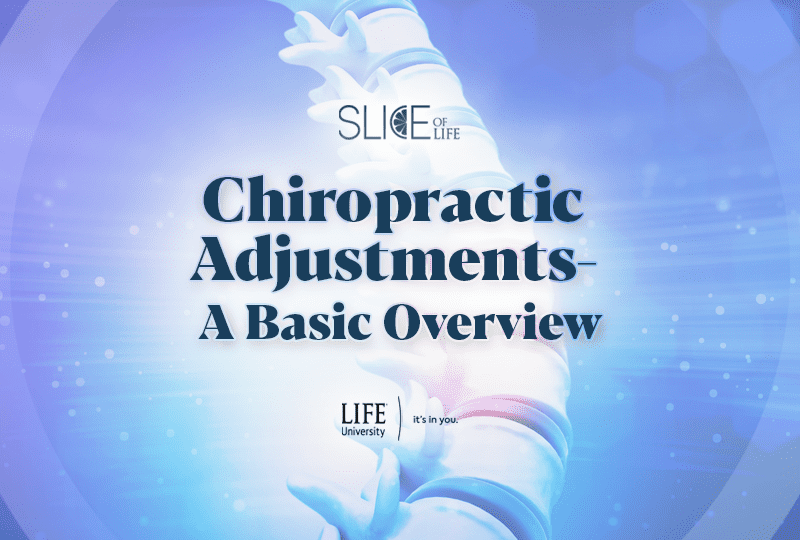Chiropractic adjustments are the basis of most chiropractic practices, offering alleviation and prevention of pain symptoms to patients. However, many people who have not had the benefit of chiropractic education might find the prospect of a chiropractic adjustment a bit confusing without at least a basic understanding of the physical ramifications and goals that their practitioner has in mind. To that end, it proves wise to take the time here to explain in simple terms what exactly is a chiropractic adjustment.
What is a chiropractic adjustment?
According to the Foundation of Chiropractic Progress’ article titled “What Happens During a Chiropractic Adjustment?”, a chiropractic adjustment is safe, controlled force applied to a joint to restore proper function and mobility, applied by or under supervision of a licensed chiropractor.
Chiropractic adjustments can help alleviate and treat many health issues such as allowing for restoration of normal range of motion, normalization of nerve function, relaxation of muscles prone to spasm, decrease harmful inflammation and much more. Commonly, adjustments are issued by hand with a swift but gentle thrust aimed at an intended specific joint location in order to restore function.
However, there are many kinds of chiropractic techniques that a Doctor of Chiropractic (D.C) might choose to employ. In general terms, your DC may employ hands-on methods of adjustment and/or chose to utilize specialized tables and technology. The techniques used will be based on your individual needs as a patient, taking into consideration body type and your unique health concerns, such as conditions like osteoporosis. This individualized approach is to ensure that the treatment given is well suited to your needs, preferences and comfort.
A major advantage of chiropractic care is that it is extremely precise and intentional in order to address specific needs in specific areas of the body. DCs have extensive knowledge of human anatomy, which they use to examine and palpate the spine with their most vital instruments, their hands, to determine which joints need attention and readjustment to line up properly along the desired x-y-z axis. Once DCs identify where adjustment is needed, they can then apply precise pressure to that area. Chiropractic care is often associated with spinal, hip and pelvic alignment, but DCs can also address other joint issues in the body, such as those related to the upper and lower extremities like the hands, arms, legs and feet.
What’s that sound?
When you were a kid, did you ever pop your knuckles and hear a satisfying pop sound? Many people wonder where that sound comes from, especially when it is louder and resulting from a chiropractic adjustment. It can create a bit of anxiety if you are not aware of the very normal and beneficial process that is actually taking place.
To the uninformed person, these popping sounds might make them think of bone cracking or rubbing when in fact the true source is a DC’s adjustment of synovial joints. Synovial joints are freely movable joints where two bones meet at a joint capsule, filled with a lubricant known as synovial fluid. This fluid serves as a source of nutrients for joint cells and contains a number of dissolved gases such as oxygen, carbon dioxide and nitrogen. When the joint is stretched, the pressure created in the fluid builds up and can cause the gases to interact, resulting in the popping sound. Typically, DCs will take great care to explain to first-time patients that these popping sounds are indeed harmless. As it is an important point, remember that any popping sounds from a chiropractic adjustment are not in fact related at all to any cracking of bones, but rather the helpful adjustment of the joints.
Since this is a basic overview intended for the general knowledge of current and potential chiropractic patients, we won’t go into too much more depth, but we hope that this has cleared up some confusion. To close, please note that adjustments should only be applied by or under supervision of a licensed professional, as it is possible to cause injury without the proper training.
References (from original Foundation for Chiropractic Progress article)
1 Palmer College of Chiropractic website, accessed January 2022,
https://www.palmer.edu/about-us/what-is-chiropractic/
2 The American Chiropractic Association website, accessed January,
https://www.acatoday.org/news-publications/newsroom/chiropractic-frequently-asked-questions/2022
3 The Library of Congress website, https://www.loc.gov/everyday-mysteries/biology-and-human-anatomy/item/what-causes-the-noise-when-you-crack-a-joint/
4 Lumbar Zygapophyseal (Facet) Joint Pain K. Saravanakumar and A. Harvey, Rev Pain. 2008 Sep; 2(1): 8–13. https://www.ncbi.nlm.nih.gov/pmc/articles/PMC4589934/
5 The clinical aspects of the acute facet syndrome: results from a structured discussion among European chiropractors Lise Hestbaek,¹ Alice Kongsted,¹ Tue Secher Jensen,² and Charlotte Leboeuf-Yde¹ Chiropr Osteopat. 2009; 17: 2. https://www.ncbi.nlm.nih.gov/pmc/articles/PMC2642848/
6 Clinical effectiveness of the activator adjusting instrument in the management of musculoskeletal disorders: a systematic review of the literature Tiffany Huggins, BA(Hons), BEd, DC, Ana Luburic Boras, BA, DC, Brian J. Gleberzon, DC, MHSc,* Mara Popescu, BA, DC, and Lianna A. Bahry, BKin, DC J Can Chiropr Assoc. 2012 Mar; 56(1): 49–57. https://www.ncbi.nlm.nih.gov/pmc/articles/PMC3280118/
7 Cartilage and diarthrodial joints as paradigms for hierarchical materials and structures V C Mow¹ , A Ratcliffe, A R Poole Biomaterials . 1992;13(2):67-97.
https://pubmed.ncbi.nlm.nih.gov/1550898/
8 What effect can manual therapy have on a patient’s pain experience? Mark D Bishop,* 1, 2, 3 Rafael Torres-Cueco, 4 Charles W Gay, 1, 2 Enrique Lluch-Girbés, 4 Jason M Beneciuk, 1, 5 and Joel E Bialosky 1, 2 Pain Manag. 2015 Nov; 5(6): 455–464.
https://www.ncbi.nlm.nih.gov/pmc/articles/PMC4976880/
Slice of LIFE is an invitation to and extension of everything happening at Life U. Whether you are a current student, a potential freshman or a proud alumni, Slice of LIFE can help keep you connected to your academic community. Know of a compelling Life U story to be shared, such as a riveting project, innovative group or something similar? Let us know by emailing Marketing@life.edu.
For more information about Life U’s Doctor of Chiropractic program, visit life.edu/academic-pages/chiropractic-program/doctor-of-chiropractic/


Social Media